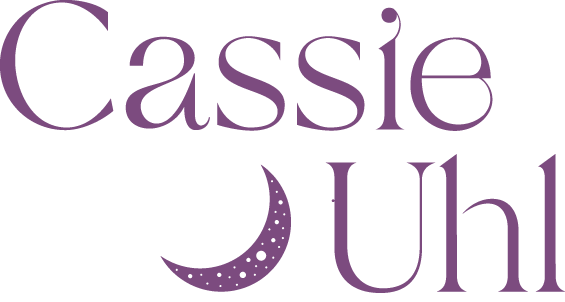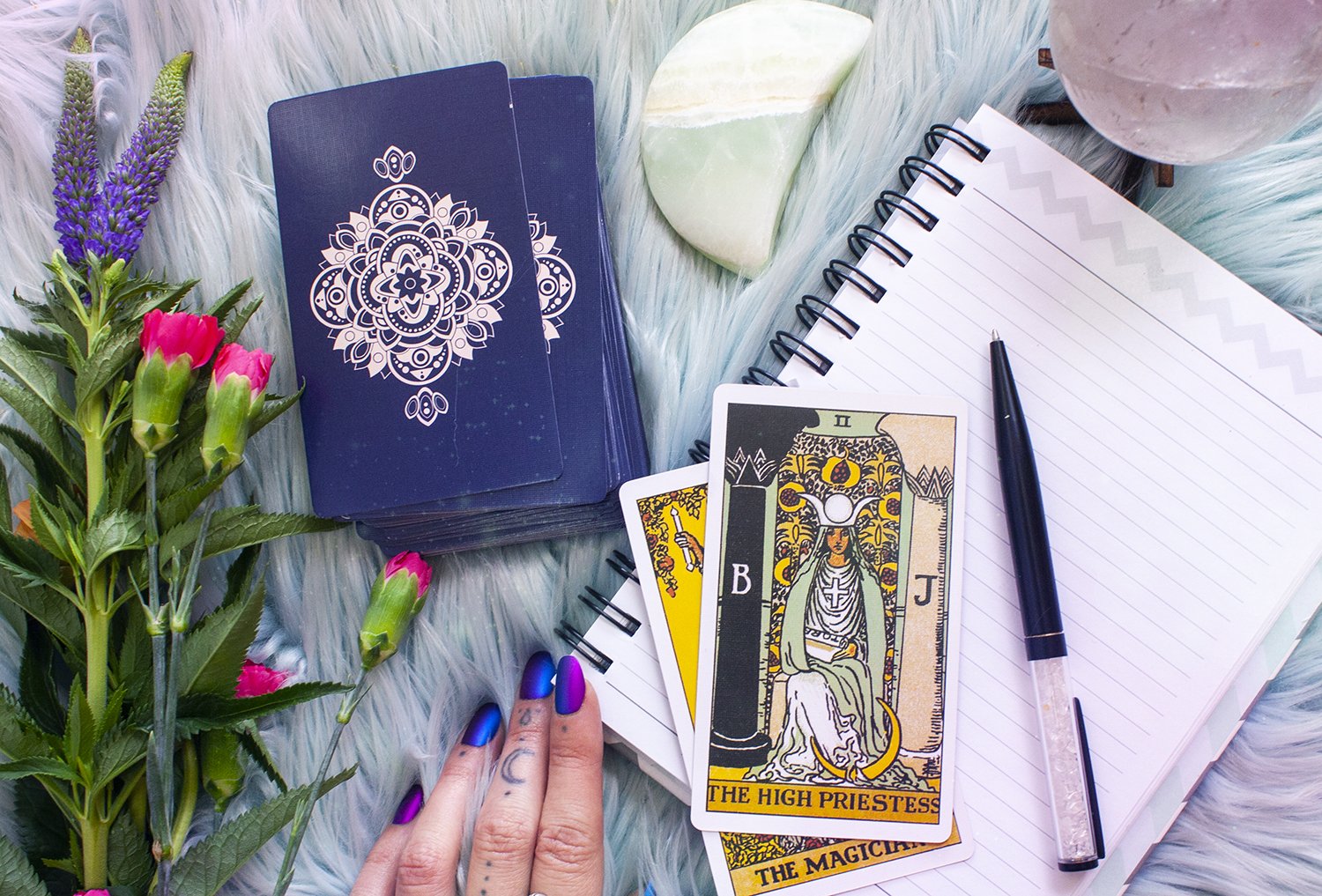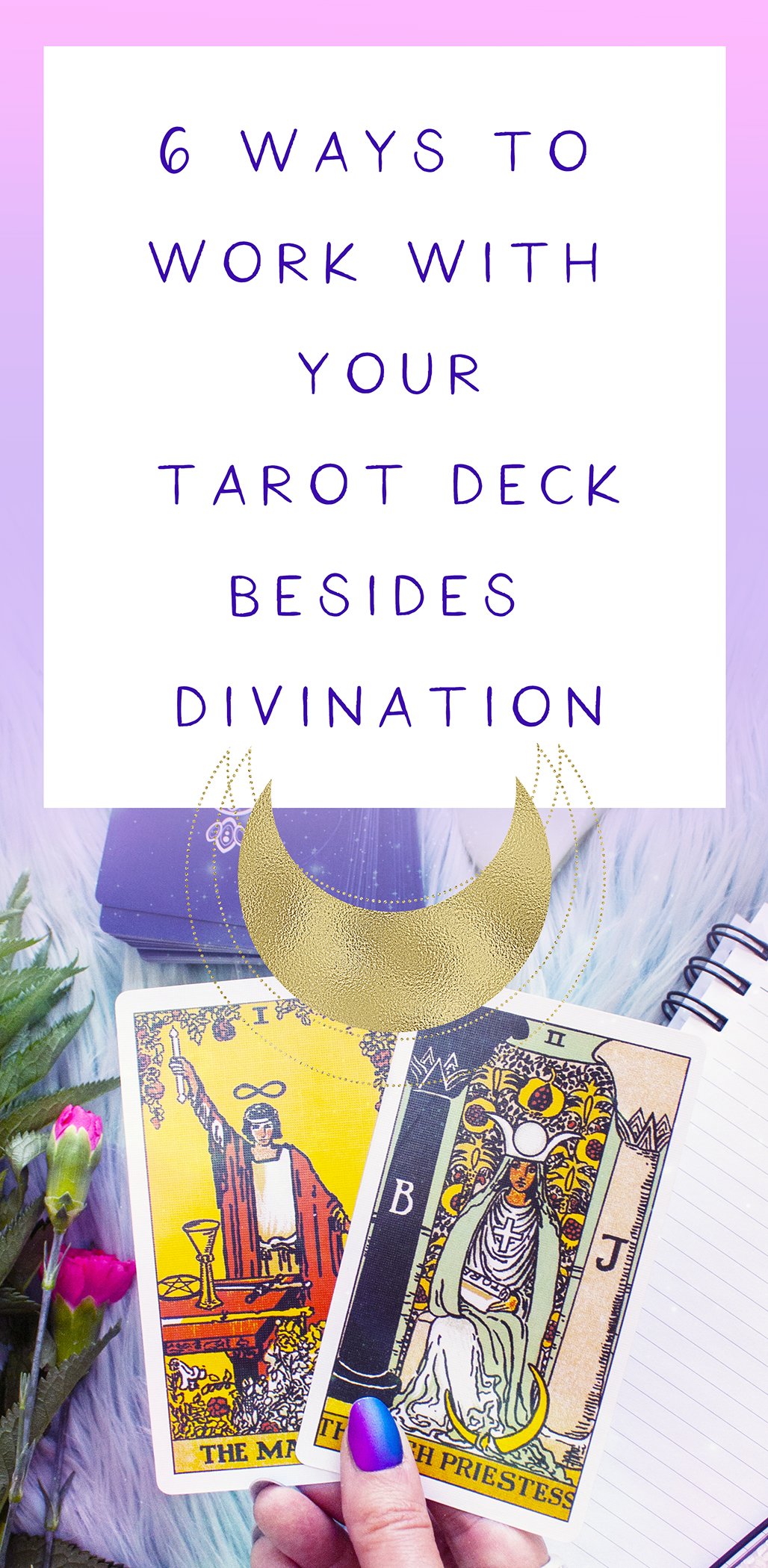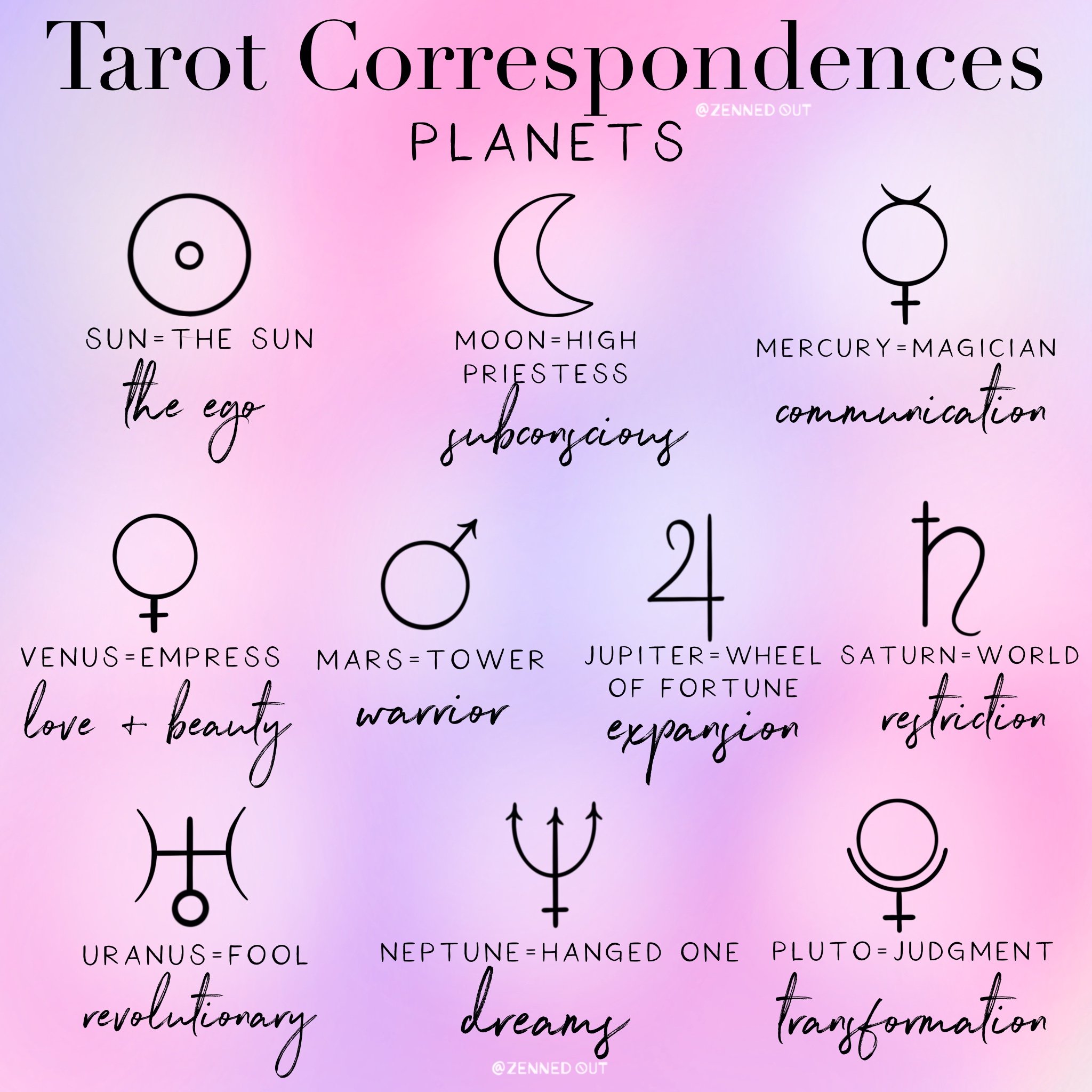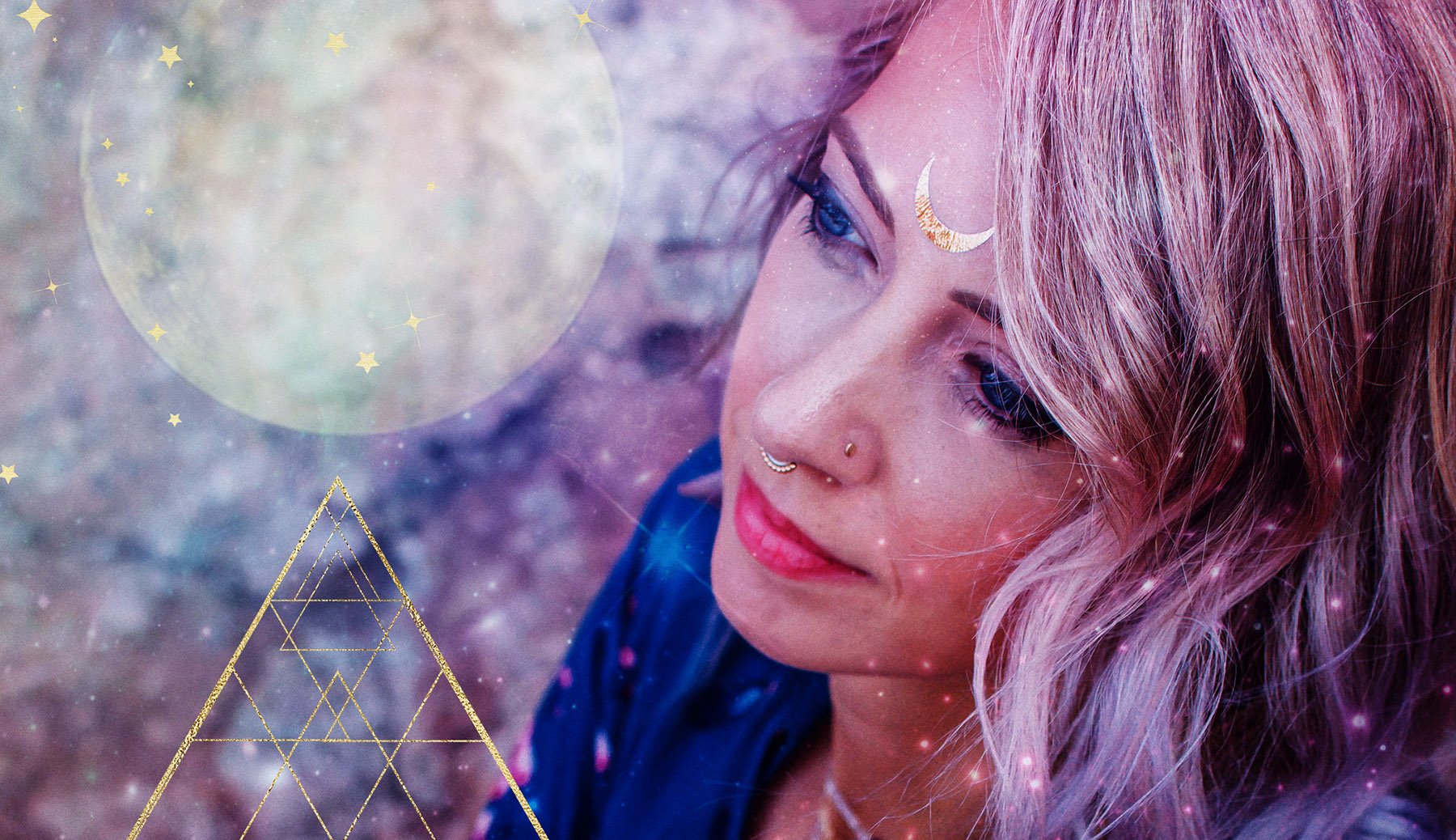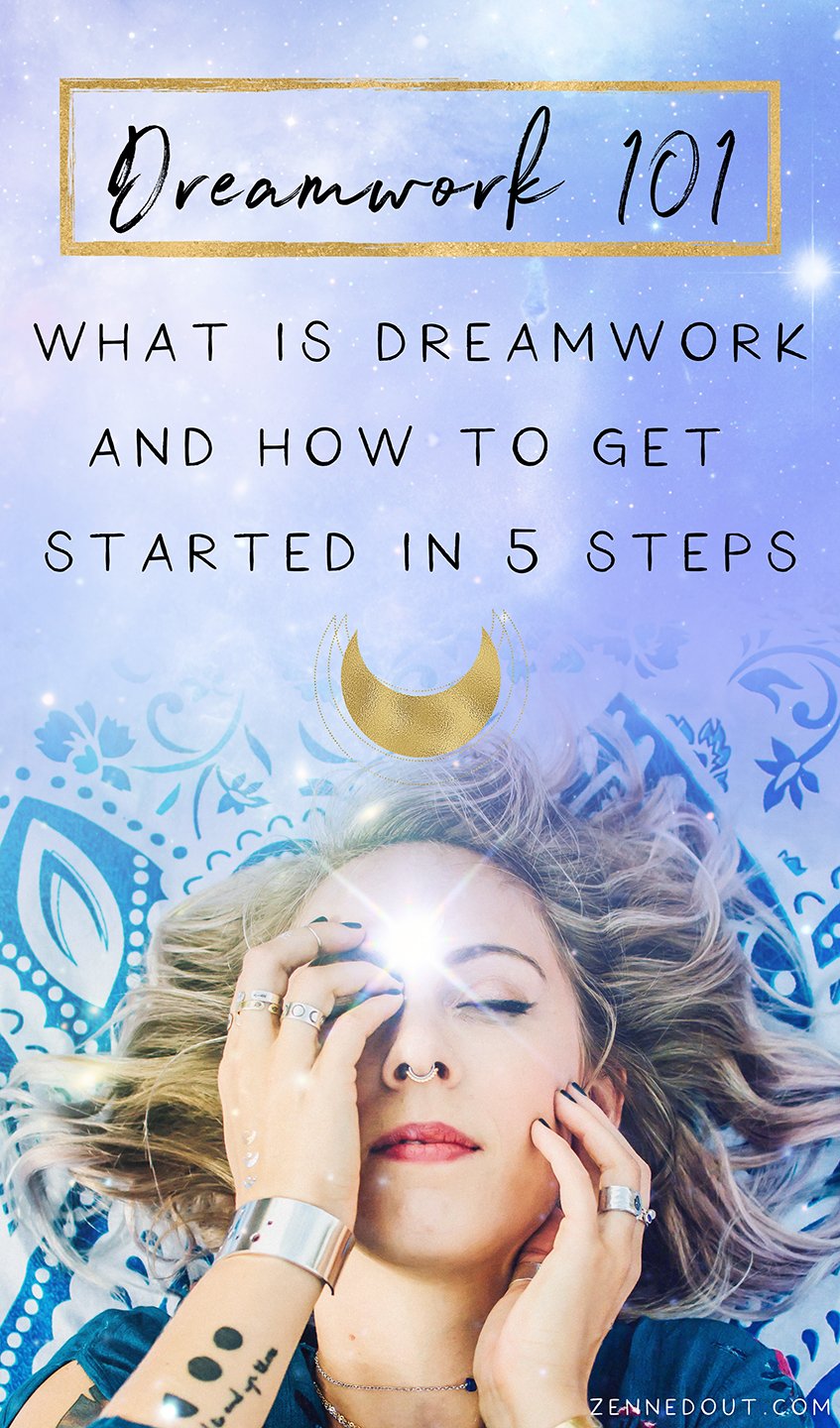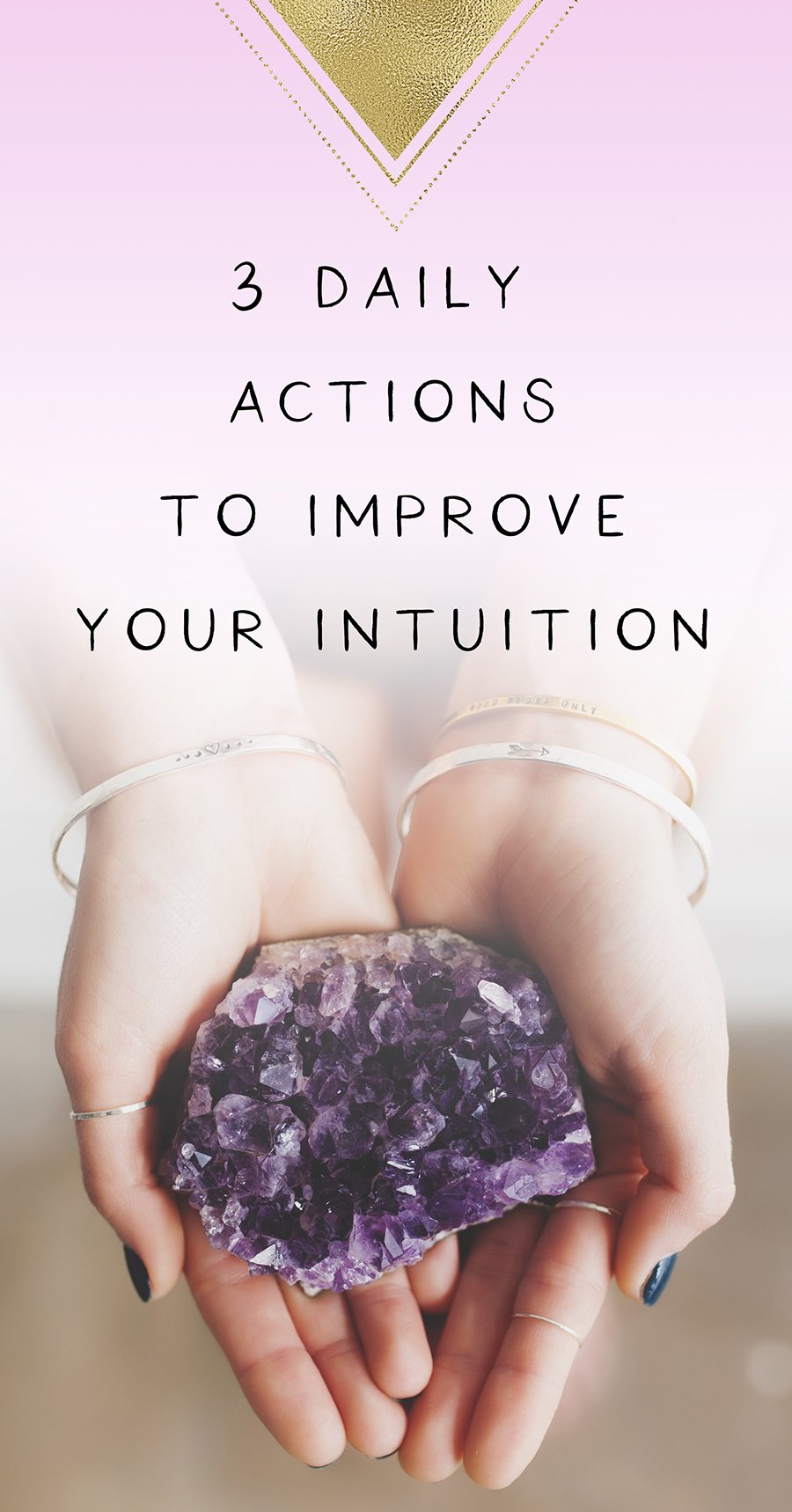6 Ways to Work With Your Tarot Cards Besides Divination
Divination is a fantastic way to work with the tarot, but you’re selling yourself short with your trusted tarot deck if you’re only using it to glean insights into the future. At its core, and in my opinion, the tarot is a powerful self-reflective tool. It’s here to share insights and guidance about what’s going on with you right now, at this moment. Telling the future is one of the most common draws to tarot, but the tarot truly brings a host of other benefits.Read on for six ways to work with the tarot to grow and expand in new ways, aside from divination.
Divination is a fantastic way to work with the tarot, but you’re selling yourself short with your trusted tarot deck if you’re only using it to glean insights into the future. At its core, and in my opinion, the tarot is a powerful self-reflective tool. It’s here to share insights and guidance about what’s going on with you right now, at this moment. Telling the future is one of the most common draws to tarot, but the tarot truly brings a host of other benefits.
Read on for six ways to work with the tarot to grow and expand in new ways, aside from divination.
Working with Common Archetypes
The tarot is full of common archetypes that you will encounter or embody at different times in your life. Archetypes are timeless and universal energies that people can understand across cultures. For example, the archetype of the mother is something we can all understand on some level. Even if you do not have a relationship with your biological mother or have children of your own, the overarching energy of the archetype of the mother is something you can understand. Furthermore, you do not have to be a mother or a woman to embody the mother's archetype. Anyone can access and learn from the energy of motherhood.
The tarot is dripping with common archetypes, especially in the major arcana. The way the archetypes show up can be personal and vary from person to person. Most of the common archetypes appear in the major arcana, but they can also be found in the minor. Here are some of the archetypes I associate with the cards: the ego (the sun), soul (the moon), mother (empress), father (emperor), wizard (magician), child (the fool), lover (the lovers), martyr (hanged one), seer (hermit), and authoritarian (hierophant), etc. You may decide on different archetypal associations with different cards, and that’s fine.
So, how can you work with the archetypes of the tarot? Lots of ways! You can explore how the archetypal energies associated with the cards make you feel, you can look at the symbology on each card and explore how it makes you feel about its archetype, you can journal about the cards and their archetypal connections, and you can layer it into how you interact with and understand the cards.
Journaling
Journaling allows you to dive deep into the meaning and energy of each card. You’ll better understand the lessons each card wants to offer you through journaling about them. Truth be told, I’m not a big fan of journaling. Journaling with the tarot is different, though. I always write when I pull cards for myself. To begin journaling with the cards, you can work through them one at a time in order or intuitively select a card to journal about. Here are some suggestions for questions to ask yourself when you’re journaling about different cards:
How does this card make me feel?
What symbols or imagery jumps out to me?
Are there any archetypes or human themes that stand out to me in this card?
How does this card show up in my life right now?
What can I learn from this card?
Energy Readings
If you’ve followed my work long, you already know that I love all things energy! We are energy beings, and the tarot is another magical and beautiful way to work with your energy. What do I mean by this? Tarot is an excellent tool for reading your energy and understanding how to balance your energy.
Each card in the tarot corresponds with different energy. When you work with the cards specifically to assess your energy, the cards can act as a guide for what kind of energy you may need more or less of. Each card's energy can act as a signal that you either have too much or too little of that energy.
For example, if you pull some cards to determine what your energy needs to be more balanced and you pull loads of pentacles, that would be a sign that you need more grounding in your life to feel more balanced because the pentacles relate to the element of earth.
You could also consider pulling a card for each energy center or chakra in your body to get an idea of what each energy center needs to be in better balance. I dive into this more in-depth in my book, The Zenned Out Guide to Understanding Tarot.
Exploring and Understanding Common Correspondences
If you’re a visual learner, like I am, you’ll love working with the tarot to understand common correspondences better. I won’t spend too much time talking about this here because I already covered this in a previous post here.
Basically, each of the cards has a handful of correspondences (correspondences are simply energies that match or “play well together.”) The most common correspondences are the elements, astrological energies, and numerology. I’ve found that using the tarot as a tool to understand different types of energies better is immensely helpful, especially for visual learners. The cards' symbology and meanings will add a depth of understanding to your astrology, numerology, or elemental practice. You’ll also learn the tarot card meanings faster as well.
Shadow work
The cards of the tarot contain a complete range of human experiences. It does not gloss over the hard, scary, and sometimes earth-shattering parts of life. This is one reason why, I believe, so many are nervous about diving into tarot. It’s also why it can be such a powerful healing tool.
Your cards will not shield you from your shadow. Instead, they call you to cozy up to your shadow to understand better what it has to teach you. If the idea of shadow work is new to you, check out this previous post to learn more about what shadow work is. Here are a few ways to dive into shadow work using your tarot card deck.
Journal about the cards that make you the most uncomfortable. Use the questions above from the journaling section.
Ask questions specifically to explore your shadow, like “What parts of my shadow need healing and exploring?”, “ What do I have to learn from my shadow?” or “What parts of my shadow have I been avoiding?”
Spellwork & Magick
If you’re a fan of spellwork, altars, or magick, this one’s for you (it’s also another one of my favorite ways to work with my deck.) Because each tarot card carries a unique energy, they are perfect for adding energy and intention to spellwork, magick, and your altar. Here are a couple of ways to start working your cards into your magickal practice.
Place a card on your altar to invite in a specific kind of energy. For example, if you’re focusing on improving your intuition, you could place the moon, the high priestess, or the queen of cups on your altar as a reminder and energetic intention.
Add a card to your spell. For example, if you’re focusing on bringing more abundance into your life, you could include the nine of pentacles or the empress into your spell.
Want to learn more about working with the tarot? Order my book, The Zenned Out Guide to Understanding Tarot. Or, check out some of these posts: Understanding Tarot Correspondences, The Difference Between Tarot and Oracle, 7 Tarot Myths Debunked or Understanding Tarot Birth Cards.
6 Tips to Learn the Tarot Card Meanings Quickly
So you got your first tarot deck, did a couple of solo readings, and then never picked it up again? Or, you work with tarot regularly but find yourself frustrated with being so reliant on the guidebook? One of the biggest hurdles people face when getting started with tarot is learning the card meanings. This kept me from diving deep into the tarot for years, too; I get it!There are much easier techniques to learning the meanings of all of the cards besides memorizing a guidebook word for word for 78 different cards.
So you got your first tarot deck, did a couple of solo readings, and then never picked it up again? Or, you work with tarot regularly but find yourself frustrated with being so reliant on the guidebook? One of the biggest hurdles people face when getting started with tarot is learning the card meanings. This kept me from diving deep into the tarot for years, too; I get it!
There are much easier techniques to learning the meanings of all of the cards besides memorizing a guidebook word for word for 78 different cards. Not only is memorizing a guidebook of 78-card meanings not very feasible, but it’s also an intuitive disservice in working with the tarot.
What if I told you that you could have a robust knowledge of all 78 cards by learning only 36 correspondences? I know 36 is nothing to sneeze at, but here’s the thing, the 36 correspondences I’ll layout in this post will not only help you understand the energy of each tarot card but will also help you in nearly all other facets of spellwork and magick.
What are correspondences?
Correspondences are simply energies that play well together or match. Each card of the tarot has at least a couple of correspondences, and when you better understand each card's correspondences, you’ll also understand the energy of each card. The correspondences associated with tarot are not unique to tarot and relate to numerology, astrology, witchcraft, and more. Plus, there’s a good chance that you’re already familiar with some of the correspondences that I’m going to outline in this post. If you are, that’s great! You’re already a step ahead.
Before you dive in, correspondences and their meanings can be rich and deep. They can also vary somewhat from person to person. What I share here is enough to get you started to build a strong foundation, but I recommend digging deeper into the ones you’re less familiar with.
Dive deeper into tarot correspondences in my book, Understanding Tarot. You might also find that reading an introductory book on numerology or astrology will really deepen your understanding of those specific correspondences. You can also read up on numerology and the four elements right here on the blog! Click here for more on the elements and here for more on numerology.
Let’s dive in. Here are 6 tips to help you learn the tarot card meanings quickly.
1. Understand your learning style!
Before we jump into understanding the correspondences of tarot, you need to get super clear about how you learn and use that method as we dive into the correspondences. If you’re a visual learner, get a journal and start drawing and writing down what the correspondences below mean. If you’re an auditory learner, consider listening to an audiobook about the correspondences listed below. If you learn by doing, continue working with your tarot deck to weave this knowledge into your readings. Not sure how you learn best? Try a few different ways listed above and see what sticks.
2. Understand Basic Numerological Meanings
The largest part of a tarot deck, and for many, the trickiest cards to learn, are the numbered suit cards of the Minor Arcana (think 2 of cups and 4 of wands, etc.) Understanding the basic numerological meanings will make you feel MUCH more confident with these cards. There are ways to use numerology in the Major Arcana too, which you’ll be able to learn more about in my new book. For the minor arcana, use these numerological meanings to give you clues about what each card means.
New beginnings
Balance
Creativity
Foundations
Change
Partnership
Intellect
Mastery
Endings
This one is kind of unique to tarot because, in traditional numerology, you always reduce down to a single-digit between 1-9. Fortunately, the meaning often in regards to the tarot is pretty obvious. It points to an end of a cycle and transitioning to a new phase. It has a slightly different feel than 9 in that it signals a willingness to move on.
3. Understand the 4 Elements
Earth, air, water, and fire are, in my opinion, foundational in any magickal or divination practice. The elements are the energies that we’re made of and can be utilized in nearly all facets of a spiritual and magickal practice! Each of the four elements corresponds with a suit of the minor arcana, shown here.
Cups- Water
Pentacles- Earth
Swords- Air
Wands- Fire
Now that you know more about the meanings associated with the numbered cards of the minor arcana, you can also apply the corresponding element. Now you have two things to go off of to understand the energy of each card better. Here’s a list of how the energy of the elements express themselves.
There are ways to apply your understanding of the elements to both the minor arcana's court cards and the major arcana. I discuss these more in my book, but this is a great place to start!
4. Understand Zodiac and Planetary Meanings
We’ll begin to transition more to the major arcana for this one. Each of the major arcana cards corresponds with either a planet or a zodiac sign, giving it a unique energy.
The Fool - Uranus
The Magician - Mercury
The High Priestess - The Moon
The Empress - Venus
The Emperor - Aries
The Hierophant - Taurus
The Lovers - Gemini
The Chariot - Cancer
Strength - Leo
The Hermit - Virgo
Wheel of Fortune - Jupiter
Justice - Libra
The Hanged One - Neptune
Death - Scorpio
Temperance - Sagittarius
The Devil - Capricorn
The Tower - Mars
The Star - Aquarius
The Moon - Pisces
The Sun - The Sun
Judgment - Pluto
The World - Saturn
Here are examples of how these energies express themselves. Zodiac Signs
Planetary Meanings
Sun - Ego
Moon - Subconscious
Mercury - Communication
Venus - Love
Mars - Warrior
Jupiter - Expansion
Saturn - Restriction
Uranus - Revolutionary
Neptune - Dreams
Pluto - Transformation
5. Learn how Astrological Energies Correspond with the Elements
I imagine correspondences as a web of intersecting energies that play off of each other. When you understand how these different energies match up or repel each other, it will take your understanding of the tarot cards' meanings to a deeper level.
Each of the zodiac signs and planets corresponds to an element. Now, with your understanding of the elements and basic astrology, you can weave these meanings together. Here’s a list of how the planets, zodiacs, and elements correspond with one another.
Aries - Mars - Fire
Taurus - Venus - Earth + Water
Gemini - Mercury - Air
Cancer - Moon - Water
Leo - Sun - Fire
Virgo - Mercury - Earth + Air
Libra - Venus - Air + Water
Scorpio - Pluto - Water
Sagittarius - Jupiter - Fire
Capricorn - Saturn - Earth
Aquarius - Uranus - Air
Pisces - Neptune - Water
With this information combined, we can see that the Empress corresponds to Venus, the earth element, and Taurus. Therefore the Empress card relates to love, beauty, and creation from an earthly and material perspective.
6. Pair this Knowledge with your Intuition
Think of all of this correspondence knowledge as a way to bolster your intuition. They’re not the end all be all of learning the tarot, but they go a LONG way! The more comfortable and confident you become in understanding these correspondences, the easier it will be for you to intuit the card meanings for yourself and others without a guidebook. The correspondences are better than a guidebook because they give you nudges and insights about what the cards have to tell you, rather than a definitive answer.
Learn more about building up your intuitive muscles here in this previous post.
Now it’s time for you to put these tools into practice. Find a way to learn them that works for you, and watch your ability to understand the tarot card meanings flourish!
Aries Season Ritual + Card Spread
Aries, our cardinal fire sign and first sign of the zodiac, is a fiery and dynamic sign here to bring us a fresh start. It invites us to tap into our bravery and courage, go after our dreams, tap into our inner fire, and move towards more freedom.In this blog post, I’ll be sharing a card spread and a ritual for Aries season.
Egg History & Rituals for Ostara + The Spring Equinox
Ostara, also known as the Spring or Vernal Equinox, is the dawn of the fertile season on the Wheel of the Year. Light and dark are in equal balance and moving forward, the light of the sun will outshine the dark of night, pushing nature into a flurry of growth and expansion. This season corresponds to growth, fertility, manifesting, and the maiden aspect of the Triple Goddess.
Ostara, also known as the Spring or Vernal Equinox, is the dawn of the fertile season on the Wheel of the Year. Light and dark are in equal balance and moving forward, the light of the sun will outshine the dark of night, pushing nature into a flurry of growth and expansion.
This season corresponds to growth, fertility, manifesting, and the maiden aspect of the Triple Goddess. The energy of this season calls you to begin taking concerted actions towards your desires. Eggs and hares are common symbols associated with this season, but their associations may not be as ancient as you thought.
I went down a bit of a rabbit hole, no pun intended, on this one! So, before we dive into egg rituals for you to practice, I want to share a bit about the history (we do know) of Ostara. If you don’t care, skip on through to the egg rituals, but personally, I find the history of our rituals not only interesting but important in crafting a meaningful practice.
Eggs and Ostara, Where’s the Connection?
There are a couple of stories that link Ostara to eggs and hares. One being that a hare out foraging for food found an egg and gave it to Ostara an offering for Spring (read a more elaborate version of this story here.) The other story speaks of Ostara finding a bird with frozen wings that she turned into a hare to save. The hare retaining its ability to lay eggs, laid an egg for Ostara as a show of gratitude. You can find variations of stories passed down similar to these or possibly have some in your lineage.
As with much of Pagan and spiritual practices from the Celts and Anglo-Saxons, these traditions were passed down orally. However, there’s actually no written pre-Christian evidence of the Goddess Ostara and her connection to hares and eggs. Ostara is first mentioned in a text by a Christian monk named Bede in 725 AD.
This isn’t to say that it’s not possible that ancient Northern European folks honored hares, eggs, and maiden Goddesses like Ostara and Freya during this season. Still, there’s no written evidence supporting these stories. Here’s a great article that dives deeper into the history we know about Ostara and her connection to eggs and hares.
Card feature from the Goddess Oracle by Amy Sophia Marashinsky.
When Christianity dominated these areas, the oral traditions were slowly extinguished, as well as many of the ancient practices associated with them. So the truth is, we may never know if Ostara and her connection to hares and eggs were real. You can view this as a hardship or an opportunity. I choose the latter. Not having a script for our ancestors' ancient ways offers you an opportunity to go within and form personal meaning with each season.
Give this post a listen here:
Symbolism of Eggs
Regardless of how the connection of eggs came to be associated with Ostara and this season, their connection to fertility, life, and union is found worldwide. Vedic texts reference the cosmic egg, the Orphic egg in Greece, and the Serpent’s Egg in Druidic practices, just to name a few, all of which deal with the beginnings of life and fertility.
Many of the ancient mythologies surrounding eggs tell stories of life, balance, and creation, which are all energies undoubtedly linked to the energy of the Spring Equinox. For these reasons, regardless of the history of eggs and Ostara, the egg is still a beautiful and potent symbol to work with during this season, or really anytime you’re focusing on fertility and growth.
Egg Rituals for Ostara
Here are a few simple ways to weave eggs into your Spring Equinox rituals. Vegan? No worries, use fake eggs. As with most magical practices, your intention is the most important part. Working with fake egg-shaped decorations is an ideal substitute for the real deal. You can purchase egg shapes in paper, plastic, and wood at most craft stores. For the rituals shown below, biodegradable eggs made from paper or wood are best. Please, don’t bury plastic eggs!
Eat them!: Obviously, if you’re vegan, you can skip over this one. But if you’re not, enjoy eggs in your favorite way or bake with them to connect with their energy of creation. Consider holding the egg in your hand and infusing it with your desires that you’d like to manifest over the coming months.
Decorate: Place plain or decorated eggs on your altar or in your home as a symbol of fertility, balance, and growth. If you’re using real eggs, you can blow out the contents of the egg with a needle and a straw; otherwise, fake eggs will work fine as well (raw eggs shouldn’t be used if left out for more than two hours.)
Egg manifesting ritual: Write wishes, draw Runes or a Sigil on an egg (raw, hard-boiled, or a fake egg) in alignment with your desires. Bury your egg in the ground to let the fertile energy of the earth help it manifest. Amplify this ritual by burying your egg alongside some seeds. As your plants grow, they will serve as a reminder of your desires being manifested.
Egg offering: Hard boil one or more eggs and leave them as an offering out in nature to give thanks for the season's fertility and growth.
Now you can work with eggs this season and have a better idea of what we do know about their history in regards to Ostara. Remember, even though we don’t have written history, it doesn’t mean that Ostara wasn’t honored. In the end, this season is a time to work with the energy of fertility and growth, and if honoring Ostara, the hare, and eggs is a way that helps you do that, I encourage you to do so! Continue creating a practice that’s meaningful to you.
Check out our past blog posts about Ostara here.
Dreamwork 101 // What is Dreamwork and How to Get Started in 5 Steps
Dreamwork is the practice of tending to our relationship with our dreams. We’re dreaming every night, but many of us barely remember our dreams, or if we do, don’t spend much time thinking about them or working with them.(How often have you dismissed a dream as, “oh, it was just a dream?”)
Dreamwork is the practice of tending to our relationship with our dreams. We’re dreaming every night, but many of us barely remember our dreams, or if we do, don’t spend much time thinking about them or working with them.
(How often have you dismissed a dream as, “oh, it was just a dream?”)
But dreams can have a lot to teach us and offer us when we enter into a deeper relationship with them. The dreamworld is rich with feelings, desires, needs, and possibilities. Our understanding of what the dreamworld evokes and presents can support our physical lives and our connections to ourselves.
In this blog post, I’ll share a bit about how to start a dreamwork practice of your own.
Dreamwork Lineage
First, I’d like to share my dreamwork lineage. What I know about dreamwork comes from the work of these folks in particular, as well as my own intuition and my ancestors:
These are wonderful people to go deeper into dreamwork with if you feel so called.
1. Support Dream Recall + Sleep
The simplest of ways to begin supporting your dreaming is by supporting sleep and dream recall. It’s difficult to consciously work with our dreams if we’re not sleeping well or can’t remember our dreams when we wake up. Everyone is different, but here are some things you might like to explore to support your sleep:
Set screen time boundaries for a certain amount of time before bed
Drink a tea to support your sleep, like chamomile (always do your own research and check with a professional before ingesting herbs)
Create your own sleep ritual that helps you shift into rest mode
Meditate and/or do a gentle, restorative yoga practice
Take a few minutes to journal brain-dump style to help clear your mind.
To support your dream recall, there are a few things I find helpful:
Set an intention to dream and to remember your dream(s) before you go to sleep (you can write this down, say it out loud, or just tell it to yourself silently)
Take a few minutes in bed in the morning before you get out of bed (or look at your phone) to give yourself space to remember your dream.
Create a dream altar and meditate at it before bed to welcome your dreams to come
Pay attention to the dreams you do receive by tending them (more on that below!)
2. Start a Dream Journal
This is probably the number one tip anyone you ask about dreamwork will give you, and with good reason! A dream journal creates a container for tending your dreams, helps solidify your intention to connect with your dreams, and helps you understand your dreams.
I recommend choosing a dedicated journal for your dreamwork and placing it on your dream altar when you’re not using it if you have one. As soon as you wake up (definitely before you look at any devices), put pen to paper and record your dream. Try recording your dreams in the present tense to honor its aliveness (for example, instead of "I was walking by a river,” try “I’m walking by a river).
If it feels available to you, you might like to marinate in the dream in bed for a few minutes before actually getting up and reaching for your journal to record.
3. Explore Dream Feelings & Textures
After you record your dream, there are many ways to work with it more deeply and explore the messages it might have for you.
I like to explore the dream textures: what are the textures, sights, smells, tastes, sounds of the dream? What do those senses mean for you and evoke for you? How do they make you feel? How does the dream, in general, make you feel?
4. Understand Dream Associations
As you work with the dream you’ve recorded, notice what stands out to you. Maybe your red dress feels particularly alive, or the hawk sparks something for you, or you feel curious about a figure in your dream.
Whatever you feel curious about, do a bit of freewriting about it. List out: what does this thing make you think of? How does it make you feel?
For example, some associations that come up with hawks for me:
Hawk feather
Maggie Smith’s poetry book Good Bones
Mothers
Protecting your children
Imagination
Play
Notice how I’m not so focused on the hawk itself, but I follow the threads of what each thing is associated with! Now I have something interesting to work with and can ask myself questions like, "what’s my relationship with play right now?"
Some of the associations you make might really surprise you and can offer deeper insight into your dream.
5. Assign Dream Correspondences
As you continue to work with your dreams, you start to develop some personal symbols and correspondences.
Like you saw above in my example with the hawk, I could make a section in my journal where I note that hawk led me to mothers and children and play. When I see a hawk again in my dream, I have that reference and can ask myself if/how it applies to this dream.
Over time, you can deepen your understanding of your own personal dream symbols and correspondences. I love this practice so much because, to me, it’s not about what a certain symbol means but about what it means to you, how it feels in your body, how it resonates with your ancestry. That’s what feels potent and powerful!
Dreams Aren’t Your Personal Vending Machine
It feels important to state that working with dreams isn’t just asking a question and receiving an answer. Generally, it’s not a simple or linear way of working. There isn’t one true or hidden meaning that we need to uncover.
In my eyes, dreams and the dreamworld are alive. So it truly is a practice of engaging in relationship with, of exploring. You might like to ask yourself, "how can I be in equal exchange with my dreams?" How can I honor the dream world and not just extract from it?
Dreams have such potential to expand us out of binary thinking and into visionary possibilities, especially if we acknowledge that power and allow them to take us there!
Going Deeper with Your Dreams
Another way to explore dream tending and go a bit deeper is by asking for a dream. I share how to do this in the dreamwork ritual I shared for Pisces season, which you can find here.
Feel free to contact us and share: how is your dream practice going? How is your relationship with your dreams evolving?
3 Daily Actions to Improve Your Intuition
You’ve probably heard the phrase that “intuition is a muscle.” If this phrase is new to you, guess what? Your intuition is a muscle that can be strengthened and honed! Some come into this world with extremely active intuitive gifts, just like some people come into this world with a knack for certain instruments or sports. But for most people, intuition is something that takes some practice.
You’ve probably heard the phrase that “intuition is a muscle.” If this phrase is new to you, guess what? Your intuition is a muscle that can be strengthened and honed! Some come into this world with extremely active intuitive gifts, just like some people come into this world with a knack for certain instruments or sports. But for most people, intuition is something that takes some practice.
So, if your intuition is a muscle, you might be wondering, “What should I be doing to take my intuition to the metaphorical gym?” As a naturally intuitive person, I’ve spent years working with and refining my intuition and psychic abilities (think of psychic abilities as a super fine-tuned intuition.) There are a few things that I’ve found are key in keeping my intuitive abilities strong and progressing my intuitive abilities into the psychic realm.
Before we jump in, I’d like to point out that we all experience intuitive and psychic information differently. If you’re not familiar with all of the “clairs,” I’m going to break them down for you here quickly. If you’d like to dive deeper into learning about the clairs, check out this past post here.
Clairvoyant: Sees visions, spirits, auras, and energy in the mind's eye or physically. Even though being clairvoyant is the most commonly referenced clair, it is by no means the most common!
Clairsentient: A common trait of empaths. Clairsentients can tap into people's energy fields, places, and things and sense information about them.
Clairaudient: May hear specific sounds for different kinds of energy or hear messages from spirit either aloud or within the mind. ⠀⠀⠀⠀⠀⠀⠀⠀⠀⠀⠀⠀⠀⠀⠀⠀⠀⠀
Claircognizant: Intuition on hyperdrive! The claircognizant knows things without provocation. Claircognizant information may appear in dreams or as a sudden gut instinct. ⠀⠀⠀⠀⠀⠀⠀⠀⠀⠀⠀⠀⠀⠀
Clairtangent: Another word used to explain this is psychometry, or the ability to know things by holding an object. However, clairtangency is not limited to holding inanimate objects and may receive information by placing their hands on people or animals.⠀⠀⠀⠀
Understanding the different ways intuitive information may come through will make understanding your intuition much easier.
Here are 3 Daily Activities to Strengthen Your Intuition. I suggest practicing these in this order, every day for at least a week, to see results.
1. Meditate Every Day For 10-20 Minutes
Regular meditation will get you in the habit of quieting your mind and tuning in to your intuition. Before you run off and say you don’t have time or can’t meditate, I want you to know that this doesn’t have to be 30-60 minutes of quiet meditation. My daily meditation practice usually ranges from 10-20 minutes, with rare longer meditations for special occasions.
Even if you need to start at five minutes a day, you will notice a difference in your ability to tune into your intuition. Our modern world comes with many distractions, so it’s important to get in the habit of quieting your mind regularly. Learn more about creating a daily meditation practice in another post I shared here.
If sitting in meditation doesn’t work for you, I invite you to try different forms of mindfulness, like walking meditation, breathwork, or even becoming more aware of the present moment while doing daily chores and tasks.
Check out guided meditations and journeys here.
2. Select One Intuitive Tool to Work With Daily
Select one intuitive tool to work with daily. Yes, the same one. Working with the same tool consistently will take out some of the variables for strengthening your intuition and better learning how it presents. Spending daily time with a single intuitive tool will also help you gain confidence with that specific tool. This step is ideal to do right after your daily meditation. Try to work with your intuitive tool for 10-20 minutes.
Once you select your tool, you’ll want to develop a system to use daily that doesn’t take very long (unless you have the time, in which case, take as much time as you’d like!) I’ve found that it’s easier to stick with new practices if I make them short and easy to work into my routine. For example, if you’re working with tarot or oracle cards, ask for daily guidance and pull 1-3 cards. Alternatively, if you want to try a daily scrying practice, I suggest setting a timer for an amount of time you can commit to the practice daily.
Here’s a list of common tools. I’ve also linked them to previous blog posts if you’d like to learn more about them.
Oracle cards (get a free printable mini oracle card deck)
Runes (get a set of free printable rune tiles)
If there’s a different intuitive tool within your practice that isn’t listed here, that’s great too. Pick something that works for you and that you’ll be able to commit to using daily.
3. Connect with Intuition in Your Body
Last, and in my opinion, most important, tune into your physical body often while doing your intuitive practice. This is where the real muscle toning comes in to build your intuition. Learning how to connect your intuition into your body is important for a couple of reasons. First, you must have the ability to root into the physical body to expand into the spirit realm. Second, intuition will always show up in the physical body somehow, subtly as it may be. Learning how to sense how and where your intuition presents in your physical body is where the fine-tuning comes in.
Your intuition may show up as a sensation in the gut (there’s a reason for the term “gut feeling”), a sense of lightness in your heart, a flash of insight in your mind, a ringing in your ear, or something else. Your daily work will be to look for patterns in how your intuition speaks to you. How you recognize your intuition in your body will likely be unique and may vary for “yes” and “no” answers and the kind of intuitive work you’re doing.
To work this into your daily intuitive practice, check-in with your body often as you meditate and work with your intuitive tool of choice. Ask your body to show you where and how your intuitive voice speaks to you. The more you practice this, the more confident and familiar you’ll become with recognizing your intuition.
You can benefit from these intuition-building tools for as little as twenty minutes a day. I think you’ll see benefits in as little as a week, but of course, like all muscles, the longer you practice, the stronger it will get! Learn more about getting grounded and working with intuition through the third eye chakra in my book, Understanding Chakras.
